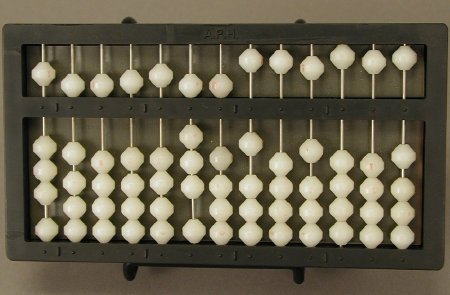Object ID:
2007.29.25
Title:
Large Cranmer Abacus
Creator:
American Printing House for the Blind
Description:
Black polystyrene frame, black panel in back secured with contact cement; thirteen steel rods filled with conical white nylon beads, four beads on each rod in the lower side of the frame and one in the upper area; friction pad below beads composed of clear plastic and a dark fabric; cast into frame in upper middle, "A.P.H."
Dimensions:
H-4.5 W-8.25 D-0.75 inches
Date:
ca. 1974
Made by:
American Printing House for the Blind
Place of Origin:
Louisville, KY
Collection:
APH Collection
Provenance:
Prototype of the APH Large Abacus, introduced between 1972 and 1977. Found in the office of long-time employee Jim Hill, who used to work in Educational Aids. The conical beads were designed to aid grip. The actual production model used red felt as a friction pad similar to the regular size model. In 1962, Carson Nolan and June Morris in Educational Research led an APH project in which 150 abacuses were made at APH and tested for use by blind students at the Perkins School for the Blind in Watertown, MA and in Cincinnati public schools. Fred Gissoni traveled to the schools to train instructors and students in use of the abacus, which was based on Terence (Tim) V. Cranmer's design and which would later be produced as the Cranmer Abacus at APH. After 12 weeks of testing, it was found that the students using the abacus had an increase of 4 grade levels in their mathematical skills. The large abacus was developed for young students or those without fine motor skills.
Credit Line:
APH Collection, 2007.29.
